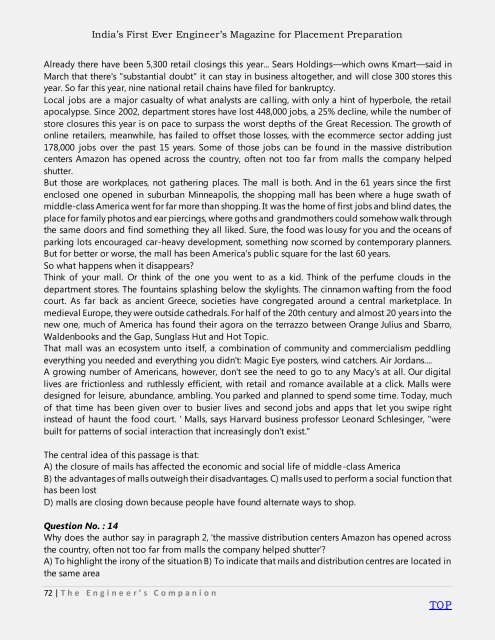The Engineer's Companion-October Magazine Edition
Create successful ePaper yourself
Turn your PDF publications into a flip-book with our unique Google optimized e-Paper software.
India‟s First Ever Engineer‟s <strong>Magazine</strong> for Placement Preparation<br />
Already there have been 5,300 retail closings this year... Sears Holdings—which owns Kmart—said in<br />
March that there's "substantial doubt" it can stay in business altogether, and will close 300 stores this<br />
year. So far this year, nine national retail chains have filed for bankruptcy.<br />
Local jobs are a major casualty of what analysts are calling, with only a hint of hyperbole, the retail<br />
apocalypse. Since 2002, department stores have lost 448,000 jobs, a 25% decline, while the number of<br />
store closures this year is on pace to surpass the worst depths of the Great Recession. <strong>The</strong> growth of<br />
online retailers, meanwhile, has failed to offset those losses, with the ecommerce sector adding just<br />
178,000 jobs over the past 15 years. Some of those jobs can be found in the massive distribution<br />
centers Amazon has opened across the country, often not too far from malls the company helped<br />
shutter.<br />
But those are workplaces, not gathering places. <strong>The</strong> mall is both. And in the 61 years since the first<br />
enclosed one opened in suburban Minneapolis, the shopping mall has been where a huge swath of<br />
middle-class America went for far more than shopping. It was the home of first jobs and blind dates, the<br />
place for family photos and ear piercings, where goths and grandmothers could somehow walk through<br />
the same doors and find something they all liked. Sure, the food was lousy for you and the oceans of<br />
parking lots encouraged car-heavy development, something now scorned by contemporary planners.<br />
But for better or worse, the mall has been America's public square for the last 60 years.<br />
So what happens when it disappears?<br />
Think of your mall. Or think of the one you went to as a kid. Think of the perfume clouds in the<br />
department stores. <strong>The</strong> fountains splashing below the skylights. <strong>The</strong> cinnamon wafting from the food<br />
court. As far back as ancient Greece, societies have congregated around a central marketplace. In<br />
medieval Europe, they were outside cathedrals. For half of the 20th century and almost 20 years into the<br />
new one, much of America has found their agora on the terrazzo between Orange Julius and Sbarro,<br />
Waldenbooks and the Gap, Sunglass Hut and Hot Topic.<br />
That mall was an ecosystem unto itself, a combination of community and commercialism peddling<br />
everything you needed and everything you didn't: Magic Eye posters, wind catchers. Air Jordans....<br />
A growing number of Americans, however, don't see the need to go to any Macy's at all. Our digital<br />
lives are frictionless and ruthlessly efficient, with retail and romance available at a click. Malls were<br />
designed for leisure, abundance, ambling. You parked and planned to spend some time. Today, much<br />
of that time has been given over to busier lives and second jobs and apps that let you swipe right<br />
instead of haunt the food court. ' Malls, says Harvard business professor Leonard Schlesinger, "were<br />
built for patterns of social interaction that increasingly don't exist."<br />
<strong>The</strong> central idea of this passage is that:<br />
A) the closure of mails has affected the economic and social life of middle-class America<br />
B) the advantages of malls outweigh their disadvantages. C) malls used to perform a social function that<br />
has been lost<br />
D) malls are closing down because people have found alternate ways to shop.<br />
Question No. : 14<br />
Why does the author say in paragraph 2, 'the massive distribution centers Amazon has opened across<br />
the country, often not too far from malls the company helped shutter'?<br />
A) To highlight the irony of the situation B) To indicate that mails and distribution centres are located in<br />
the same area<br />
72 | T h e E n g i n e e r ’ s C o m p a n i o n<br />
TO P


